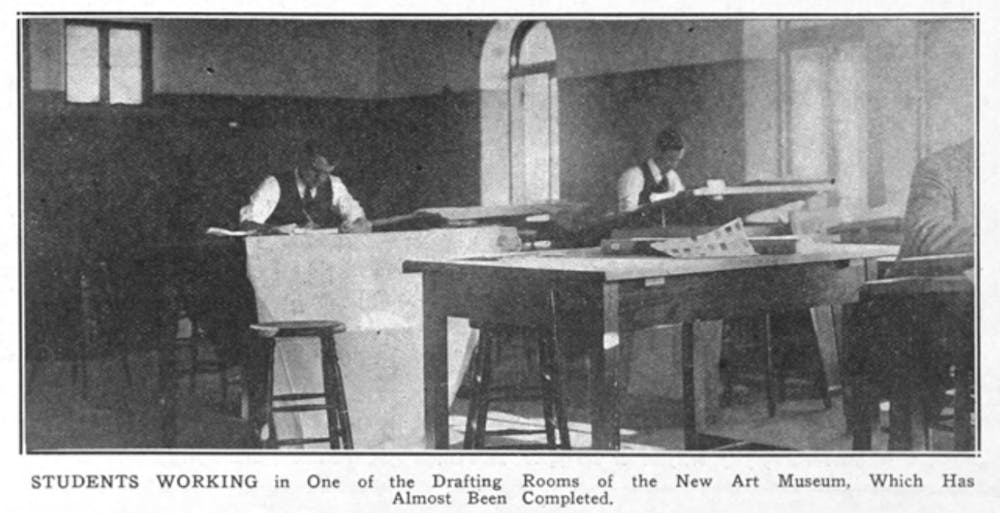Art Museum. n. “Once a sophisticated first date spot in the middle of campus. Now, a pile of construction materials that makes you walk three extra minutes to get to Firestone.”
It was with this definition that the 146th Managing Board of The Daily Princetonian introduced the art museum to the incoming Class of 2026 in its annual first-year dictionary. Since then, each incoming class has entered Princeton knowing the Art Museum for what it had been before they arrived, or for what it might become in the distant future.
While campus construction has been a theme of the last few years — an April 2023 humor piece in the ‘Prince’ advertised a magazine-style quiz asking students, “Which ongoing campus construction project are you?” — it’s nothing new. The ‘Prince’ has covered the art museum’s many demolitions and construction projects since the paper’s beginning From sketches of expansion plans to scathing letters to the editor (formerly known as the Chairman), the archives of The Daily Princetonian tell the story of an art museum that is constantly changing shape.
When the Board of Trustees met to discuss the fundraising plans for an “Art School” in February 1887, the ‘Prince’ reporters in attendance got an early look at the sketches for the University’s first art museum building. The following March, the ‘Prince’ reported that the building, which would cost $90,000 when completed, would be fireproof, with a lower story made from “Newark brownstone” and the top from brick. The new museum would house the University’s growing collection of art, some of which came from donations contingent on the fireproof nature of the building.
An 1891 column began, “As it is of much importance that all should have some knowledge of the work going on in the various departments of the college, a brief description of the especial point of interest in connection with the departments of Art and Archaeology, may here be in place.” Students who read on could learn about the paintings, pottery, and sculptures that would be on display in the new building, which was set to open in 1890.
More evolution came in 1901, when readers of the ‘Prince’ learned that Professor Allan Marquand, the Marquand Library’s namesake, had made his personal art library available to students as a companion to the art museum. In 1923, Marquand spoke at the dedication of McCormick Hall, the first addition to the original structure. A year later, the ‘Prince’ announced its opening to visitors for the first time after the expansion.
In 1930, the ‘Prince’ brought news of yet another addition, whose reception by students was made clear in a 1935 column titled, “The Great Wall of McCormick,” in which students of the “lower Campus” lamented the detours it created on their walks from Brown and Cuyler Halls to McCosh and Dickinson.
“Campus eyesore renovated during summer by vigorous potion of Princeton architects,” read a 1935 headline in the pages of the ‘Prince.’
Plans for more expansion appeared in 1957 and again in 1964 when large parts of the existing structure were demolished, leaving only a 140-foot strip of the original structure, salvaged windows, and roof tiles. A 1963 article announcing the preparations for demolition began, “A death warrant is scrawled on the door of the Art Museum.”
Despite the demolition’s critical reception — a student wrote a letter to the ‘Prince’ calling the renovation “the rape of McCormick” — the new museum opened in 1966. Its director, Patrick J. Kelleher, was quoted in the ‘Prince’ emphasizing its transformation into a “teaching museum.”
Another renovation period began in 1986, inviting complaints from seniors who had to relocate their thesis installations. When the new additions opened in 1989, Arts Editor Bruce Searby ’90 sang its praises in the pages of the ‘Prince,’ calling it a “quick fix – but one sparing absolutely nothing in quality.”
The museum was once again renovated in the early 2000’s, with Arts contributor Nathan Floody ’05 comparing the ubiquity of construction sites on campus with the volume of Starbucks stores in New York City.

“Construction on campus can be described using the old saying about Starbucks cafes on New York street corners: stand anywhere, look around, and you’ll see one,” he wrote.
15 years later, the prospect of demolition returned to the pages of the ‘Prince’ in 2018 when readers of the ‘Prince’ learned that construction would begin on a totally new museum in 2020. In 2021, in the wake of the Covid-19 pandemic, a piece by Olivia Kasule ’26 covered students’ concerns about the lack of a dedicated space for art.
Now, four years and one “Which ongoing campus construction project are you?” quiz later, the art museum is open once again. Nearly 140 years after the ‘Prince’ got to see plans for the very first art museum on campus, reporters from the ‘Prince’ covered all 24 hours of the art museum’s grand reopening, joining over a century of their predecessors in documenting the museum’s ever-shifting form.
Lianne Chapin is a Head Archives Editor for the ‘Prince.’ She is from New York City.
Please send any corrections to corrections[at]dailyprincetonian.com.








